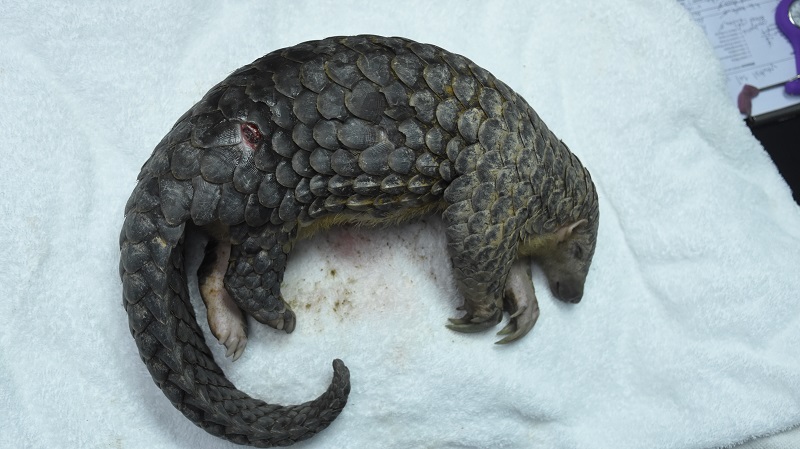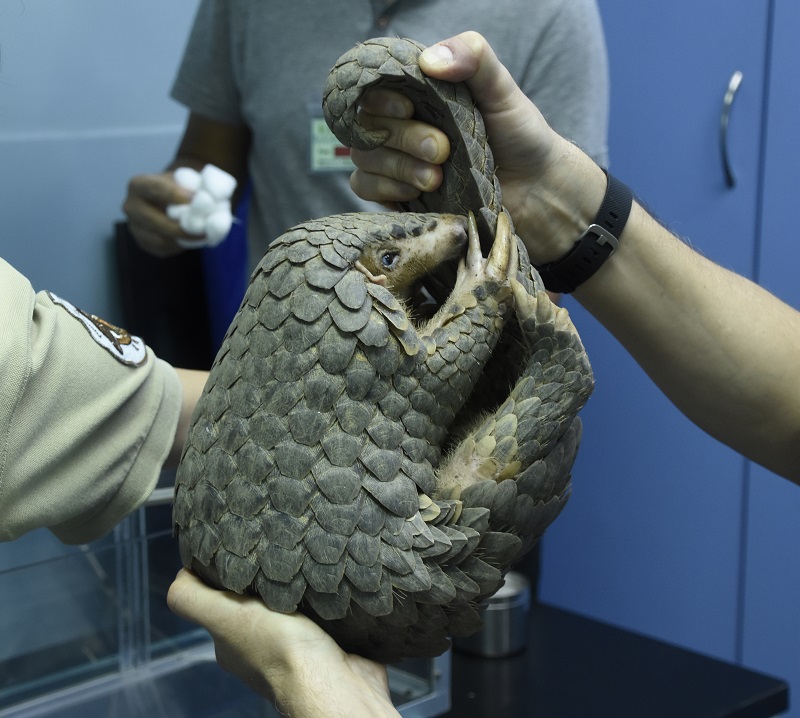Two Chinese Pangolins Rescued and Released in June 2017
Two Chinese pangolins were received and cared for by the KFBG Wild Animal Rescue Centre in the space of three weeks.
On 19 May, a juvenile female Chinese pangolin was found after she had been mauled by feral dogs. After delivery by the SPCA, our rescue team gave her a comprehensive health check, treated her three major bite wounds and kept her under close observation for two weeks during her recovery.
 This female Chinese pangolin that we received in May (pictured anaesthetized during a checkup at the KFBG Wild Animal Rescue Centre) was attacked by stray dogs and suffered from multiple wounds on her lower back.
This female Chinese pangolin that we received in May (pictured anaesthetized during a checkup at the KFBG Wild Animal Rescue Centre) was attacked by stray dogs and suffered from multiple wounds on her lower back.

We did our best to make the female pangolin comfortable at her temporary home at the KFBG Wild Animal Rescue Centre. We furnished her enclosure with leaf litter and logs to resemble her natural habitat in the woods, and gave her a wooden house to hide in just like her sleeping burrows in the wild.
We gave her four meals to choose from. The ingredients included hard boiled eggs, multivitamins, buffalo worms, apple, animal milk replacer all blended and made into a paste that is served with a sprinkle of ants and ants eggs.
---1.jpg)
Female pangolin release on 2 June
Photo source: AFCD
---2.jpg)
Female pangolin release on 2 June
Photo source: AFCD
Last Thursday (8 June), our rescue team received another pangolin. The sub-adult, male Chinese pangolin was discovered near Sha Tin Park. We performed a checkup and found the animal to be very strong and active, and fortunately he does not appear to have any significant injuries. He weighs 4.6kg, more than twice as heavy as the recently-released female. It was returned to the countryside last Friday (9 June).
 The male Chinese pangolin appeared strong and feisty during health check at the KFBG Wild Animal Rescue Centre. Pangolins, are often referred to as scaly anteaters, are covered in tough overlapping scales, possess prehensile tails used to hang from tree branches, and strong, curved claws, specialized for digging sleeping burrows and breaking into ant nests. Pangolins also have long sticky tongues – longer than the length of their body – that are used to catch ants.
The male Chinese pangolin appeared strong and feisty during health check at the KFBG Wild Animal Rescue Centre. Pangolins, are often referred to as scaly anteaters, are covered in tough overlapping scales, possess prehensile tails used to hang from tree branches, and strong, curved claws, specialized for digging sleeping burrows and breaking into ant nests. Pangolins also have long sticky tongues – longer than the length of their body – that are used to catch ants.
 Our rescue team measured the feet, ears, tail and body of the male Chinese pangolin for scientific purposes.
Our rescue team measured the feet, ears, tail and body of the male Chinese pangolin for scientific purposes.
-1.jpg)
Male pangolin release on 9 June
Photo source: AFCD

